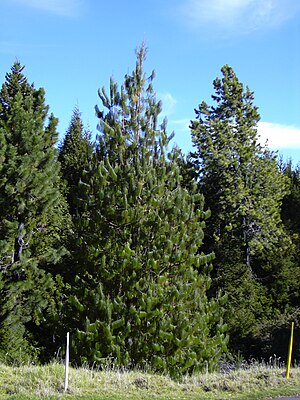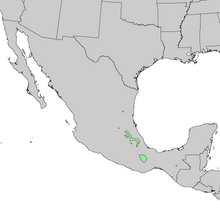Pinus patula
| Pinus patula | ||||||||||||
|---|---|---|---|---|---|---|---|---|---|---|---|---|

Pinus patula |
||||||||||||
| Systematics | ||||||||||||
|
||||||||||||
| Scientific name | ||||||||||||
| Pinus patula | ||||||||||||
| Schltdl. & Cham. |
Pinus patula is a plant from the genus of pine trees ( Pinus ) within the family of the Pinaceae (Pinaceae). It is common in Mexico .
description
Vegetative characteristics
Pinus patula grows as an evergreen tree and reaches heights of 30 to 35 meters and trunk diameters of 50 to 90 centimeters or rarely heights of 40 meters and trunk diameters of 1 meter. The trunk is usually straight and free of knots up to a height of 20 meters. The lower branches are horizontal to sometimes slightly downward and form an open, rounded crown. In mature trees, the bark is thick in the lower crown area with deep, vertical cracks. From 3 to 4 meters in height, the bark is thin, scaly and reddish to yellowish-red. On young trees the bark is thin, scaly and yellowish red. The branches are slender, sometimes slightly drooping, scaly and yellowish red. There are usually five, rarely four cotyledons .
The wood is soft, light and pale yellowish white with a slightly darker heartwood .
The needle leaves stand in bundles on short shoots in threes, sometimes in groups of four, rarely in groups of five; the sheaths are pale gray-brown, 10 to 15 millimeters long and persistent. The needle leaves are slender, 15 to 25 centimeters long, drooping, light green to yellow-green. The edge is finely sawn. There are one to four, usually three, resin channels. There are two adjacent but separated vascular bundles .
Generative characteristics
The male cones are in dense groups of two to ten, on slender stems not only on branches, but also on the trunk. Their small, thick cone scales carry a small, sloping thorn.
The female cones sit together in groups of four to eight. With a length of 7 to 10 centimeters, the female cones are oblong-conical, slightly curved, hard and brown to yellow-brown. They ripen in winter, but often remain closed for years and often only open after a fire. The cone scales are hard and stiff.
The seeds are very small with lengths of about 5 millimeters, round-long, dark brown to almost black. The seed wing is about 17 millimeters long and light brown. There are around 115,000 seeds per kilogram.
The number of chromosomes is 2n = 24.
Distribution and locations
Pinus patula has a very limited distribution. It occurs in scattered populations in the southeastern area of the Sierra Madre Oriental in Mexico, approximately between the 24th and 17th parallel north.
Pinus patula grows at altitudes from 1500 to 3100 meters in areas with 1000 to 1500 mm annual precipitation . Moisture is present all year round in the form of fog or rain. In drier areas, Pinus patula is displaced by Pinus teocote and Pinus leiophylla .
Pinus patula was used as a forest tree a. a. Introduced to southern Africa in 1907 and feral there.
Systematics
The first description of Pinus patula was carried out in 1831 Diederich Franz Leonhard von Schlechtendal and Adelbert von Chamisso in Linnaea , volume 6, page 354th
Of Pinus patula There are two varieties:
- Pinus patula var. Longipedunculata Loock ex Martínez (Syn .: Pinus longipedunculata (Loock ex Martínez) Businský , Pinus patula subsp. Longipedunculata (Loock ex Martínez) Silba ): It occurs in the Mexican states of Oaxaca as well as central Chiapas and in Hidalgo and Veracruz ( only two sites). The total distribution area is not yet fully known in 1997.
- Pinus patula Schltdl. & Cham. var. patula (Syn .: Pinus subpatula Roezl ex Carrière , Pinus patula var. macrocarpa Mast. ): It occurs in the Mexican states of Tamaulipas (only a few localities), Querétaro , Hidalgo, México , Federal District , Morelos , Tlaxcala , Puebla , Veracruz, Oaxaca and Chiapas.
supporting documents
literature
- Jesse P. Perry: The Pines of Mexico and Central America. Timber Press, Portland 1991, pp. 168ff. ISBN 0-88192-174-2 .
- A. Farjon, BT Styles: Pinus (Pinaceae). In: Flora Neotropica Monograph , Volume 75, The New York Botanical Garden, New York, 1997.
Individual evidence
- ↑ Pinus patula at Tropicos.org. In: IPCN Chromosome Reports . Missouri Botanical Garden, St. Louis
- ^ BI Nyoka 2003: Pinus patula in Southern Africa. In: Biosecurity in forestry: a case study on the status of invasive forest trees species in Southern Africa. Forest Biosecurity Working Paper FBS / 1E. Forestry Department. FAO, Rome online.
- ↑ Pinus patula at Tropicos.org. Missouri Botanical Garden, St. Louis, Retrieved April 21, 2019.
- ↑ a b c d data sheet Pinus patula at The Gymnosperm Database , 2019.
Web links
- Pinus patula at Tropicos.org. In: 33 . Missouri Botanical Garden, St. Louis
- Vascular Plants of the Americas : Pinus patula at Tropicos.org. In: 83 . Missouri Botanical Garden, St. Louis
- Pinus patula inthe IUCN 2013 Red List of Threatened Species . Posted by: A. Farjon, 2011. Retrieved November 28, 2013.




